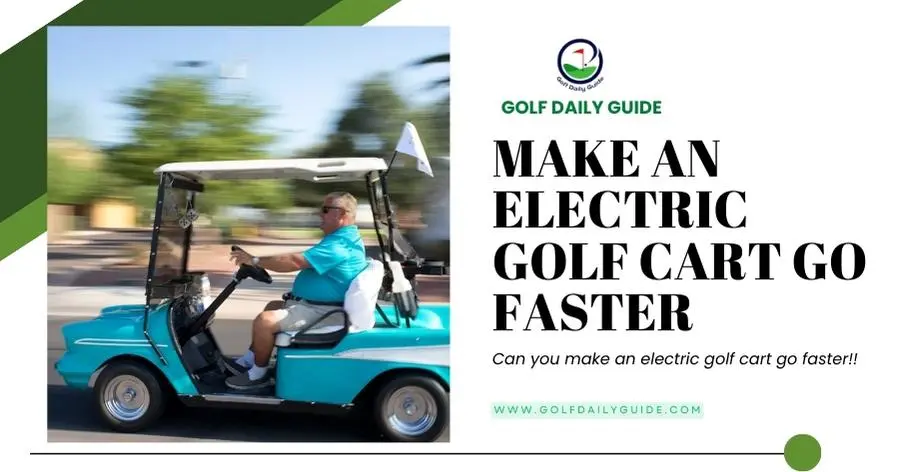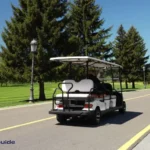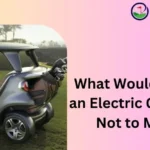The most common symptoms of a bad solenoid in an electric golf cart include no movement and a clicking sound when pressing the accelerator pedal.
When a solenoid fails, it interrupts the flow of electricity to the motor, preventing the cart from operating correctly.
This can be frustrating, but understanding the symptoms can help you quickly diagnose and fix the issue. We’ll explore the signs of a bad solenoid in an electric golf cart and the potential causes and solutions.
By familiarizing yourself with these symptoms, you can address solenoid issues promptly, ensuring a smoother and more efficient golf cart experience.
What is the best electric golf cart?
Common Bad Solenoid Symptoms
If you own an electric golf cart, you must know the common symptoms of a bad solenoid. The solenoid is a critical part of the cart’s electrical system, responsible for controlling the flow of electricity to the motor.
When the solenoid is not working correctly, several noticeable symptoms can arise.
By paying attention to these symptoms, you can quickly identify and address any issues with the solenoid, ensuring that your golf cart stays in top condition.
Sudden Loss Of Power
A sudden loss of power is one of the most apparent signs of a bad solenoid in your electric golf cart. You might experience the cart running delicate one moment, and then it suddenly becomes sluggish or completely unresponsive.
This abrupt loss of power can occur while driving or when trying to start the cart. If you notice a significant reduction in speed or the cart fails to move altogether, it could indicate a malfunctioning solenoid.
Clicking Noise When Accelerating
Another common symptom of a bad solenoid in an electric golf cart is a clicking noise when accelerating.
This clicking sound can occur when you press the accelerator pedal, usually accompanied by the cart’s decreased performance.
The solenoid is responsible for engaging and disengaging the electric current to the motor. When it fails,
you may hear a distinct clicking noise as the solenoid rapidly tries to connect but fails to do so. If you notice this clicking sound while accelerating, it’s likely time to check the solenoid.
Identifying these common symptoms of a bad solenoid in your electric golf cart is crucial for proper maintenance and timely repairs.
Watch for sudden power loss, sluggishness, unresponsiveness, and clicking noises when accelerating.
If you suspect your golf cart may have a bad solenoid, it’s best to get it inspected and repaired by a professional technician with experience handling electric golf carts.
Ignoring solenoid issues can further damage the cart’s electrical system and may result in costly repairs.
Which is better gas or electric golf cart?
Testing The Solenoid
Testing the solenoid in an electric golf cart is crucial to identify bad solenoid symptoms. Thus, By conducting proper diagnostics, you can determine if the solenoid is functioning correctly, ensuring optimal golf cart performance.
Testing the solenoid of an electric golf cart is crucial to diagnosing any potential issues. A solenoid is an essential component that controls the flow of electricity to the golf cart’s motor.
This section will discuss two effective methods for testing the solenoid: using a multimeter and visually inspecting connections.
So, These tests will help identify lousy solenoid symptoms, allowing you to take the necessary steps for repair and maintenance.

Using A Multimeter
Using a multimeter is a reliable way to test the functionality of the solenoid. This handy device measures electrical current, resistance, and voltage.
You can determine if the solenoid functions as it should with a few simple steps. First, ensure the golf cart turns off and the key is removed from the ignition.
Then, locate the solenoid, which is generally found near the batteries. Note the terminals on the solenoid; there will be two larger terminals and two smaller ones.
Thus, set your multimeter to the resistance (ohms) setting. Connect the red lead to one of the larger terminals and the black lead to the other larger terminal.
The reading should show zero resistance or be very close to it. If the multimeter displays infinite resistance or a significantly high value, it clearly indicates a bad solenoid.
Visual Inspection Of Connections
Besides using a multimeter, a visual inspection of the solenoid connections can also provide valuable information.
Start by visually examining the solenoid for any signs of damage, such as frayed wires, loose connections, or corrosion.
Corrosion can impede the flow of electricity and cause solenoid malfunctions. Inspect the wiring connections, ensuring they are tightly secured and free from wear and tear.
Pay particular attention to the terminals and look for signs of oxidation or rust. Any loose or damaged connections should be repaired or replaced promptly to maintain proper solenoid function.
Regularly inspecting and maintaining the solenoid connections can prevent potential issues and extend the lifespan of your electric golf cart.
Remember, testing the solenoid using a multimeter and visually inspecting connections are essential steps to diagnose bad solenoid symptoms.
So, These assessments will help ensure the efficient operation of your electric golf cart and enable you to take appropriate measures for repair, if necessary.
How to make electric golf cart faster?
Experiencing issues with your electric golf cart? If you notice symptoms like a clicking sound or failure to start, it could indicate a bad solenoid.
Replacing the solenoid can help resolve these problems and keep your golf cart running smoothly.
Replacing the Solenoid Gathering Necessary Tools First, gather all the tools you’ll need to replace the solenoid in your electric golf cart.
You’ll need a wrench, a screwdriver, and a voltmeter. Ensure that you have these tools ready before starting the replacement process.

Step-by-Step Replacement Process Now, let’s walk through the process of replacing the solenoid in your electric golf cart:
1. Disconnect the Power: Start by turning off the power to the golf cart and ensuring it’s in the park position.
2. Locate the Solenoid: Use the owner’s manual to locate the solenoid in the golf cart. It’s usually found near the battery compartment or the controller.
3. Disconnect Power Source: Unhook the battery’s negative terminal to prevent mishaps.
4. Remove Wires: Use your screwdriver to remove the wires attached to the solenoid. Remember their positions or take a picture for reference.
5. Remove the Old Solenoid: Remove the bolts that secure the solenoid to the golf cart frame using your wrench. Be careful not to lose them.
6. Install the New Solenoid: Position and secure the new solenoid with the bolts. Reattach the wires to the new solenoid.
7. Reconnect Power Source: Reconnect the battery’s negative terminal and turn on the power to test the new solenoid.
8. Test the Solenoid: Use the voltmeter to properly ensure the new solenoid functions. Following these simple steps, you can replace the solenoid in your electric golf cart and return to enjoying your time on the course.
What causes an electric golf cart to lose power?
Electric golf carts are a convenient and eco-friendly mode of transportation on the golf course. Preventive maintenance is essential to keep your electric golf cart running smoothly.
By proactively monitoring and addressing any potential issues, you can avoid more significant problems.
Let’s explore some preventive maintenance practices that can help avoid solenoid-related issues:
1. Regular Cleaning And Inspection:
Regularly cleaning and inspecting the solenoid and its surrounding components can help to prevent potential issues. A clean and well-maintained solenoid is less likely to develop problems.
Keep the area around the solenoid free from dirt, debris, and corrosion buildup. Regularly inspect the solenoid for any signs of wear, corrosion, or loose connections.
2. Ensuring Proper Wiring:
Proper wiring is crucial for the optimal functioning of the solenoid. Inspect the wiring connections for any signs of fraying, damage, or loose fittings.
So, Ensure that all wiring is secure and properly connected. Any damaged wiring should be promptly repaired or replaced to prevent potential solenoid issues.
Can you make an electric golf cart go faster?
If you own an electric golf cart, you may encounter issues with the solenoid. The solenoid is a crucial component that allows your golf cart to start and run smoothly.
When the solenoid malfunctions, it can cause various symptoms that affect the performance of your golf cart.

While some simple solenoid issues can be fixed on your own, there are times when seeking professional assistance is necessary:
1. Knowing When To Seek Professional Help:
Identifying the symptoms of a bad solenoid in your electric golf cart is essential. However, knowing when the problem goes beyond your DIY skills is equally important.
Here are some signs that indicate it’s time to call in a professional golf cart mechanic:
- The solenoid clicks repeatedly, but the golf cart doesn’t start
- The solenoid gets hot to the touch
- There is no power to the golf cart
- The golf cart moves slowly or struggles to accelerate
Thus, If you notice any of these symptoms, it is recommended to seek professional assistance. So, Trying to fix complex solenoid issues without proper knowledge and experience can worsen the problem and lead to expensive repairs.
2. Finding A Reliable Golf Cart Mechanic:
When finding a reliable golf cart mechanic, choosing someone specializing in electric golf carts and with experience dealing with solenoid issues is essential.
Here are a few steps to help you find the right professional:
- Ask for recommendations from fellow golf cart owners or local golf cart dealerships.
- Research online reviews and ratings of golf cart mechanics in your area.
- Contact potential mechanics and inquire about their experience with electric golf carts and solenoid repairs.
- Ask for upfront pricing estimates to ensure transparency.
- Consider checking if the mechanic is certified or affiliated with reputable golf cart associations.
By following these steps and finding a reliable golf cart mechanic, you can ensure that your electric golf cart’s solenoid issues are fixed correctly and efficiently.
Frequently Asked Questions On Electric Golf Cart Bad Solenoid Symptoms
Will An Electric Golf Cart Run With A Bad Solenoid?
Yes, an electric golf cart may not run with a bad solenoid. A bad solenoid can cause issues with the cart’s electrical system, preventing it from functioning correctly.
It is essential to have the solenoid checked and replaced if necessary to ensure the cart runs smoothly.
How Do You Test An Electric Golf Cart Solenoid?
To test an electric golf cart solenoid, first ensure it is disconnected from the power source. Then, using a multimeter, check the continuity of the solenoid’s coil by touching the probes to its terminals. If the solenoid does not show continuity, it may need replacement.
How Do I Know If The Solenoid Is Bad?
To determine if the solenoid is bad, check if the device is not functioning correctly or if it is making strange noises.
You can also use a multimeter to test the solenoid’s resistance to see if it is within the specified range. If it falls outside the range or there is no resistance, the solenoid may need to be replaced.
Why Is My Electric Golf Cart Solenoid Not Clicking?
The electric golf cart solenoid may not click due to a faulty connection or a worn-out solenoid. Check for loose wires or corroded connections and replace the solenoid if necessary. Regular maintenance and proper wiring can prevent this issue.
What Are The Symptoms Of A Bad Solenoid In An Electric Golf Cart?
A lousy solenoid in an electric golf cart can cause various symptoms, such as clicking noises when trying to start, failure to start, or a complete lack of power.
Related Post
Electric Golf Cart Bad Solenoid Symptoms
What is the gas golf cart problems
Is it bad to leave golf clubs in the cold
How to tell if a golf ball is waterlogged
What is an ostrich in golf
Bottom Line
To sum up, recognizing the symptoms of a bad solenoid in your electric golf cart is crucial for efficient and hassle-free operation.
By being aware of warning signs such as clicking noises, intermittent power, or the inability to start, you can take prompt action to address the issue and ensure the longevity of your cart.
Thus, Regular maintenance and professional assistance are vital in resolving solenoid problems and optimizing performance. Stay informed, and keep enjoying your golfing experience!












